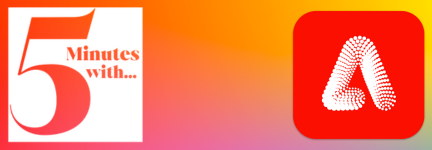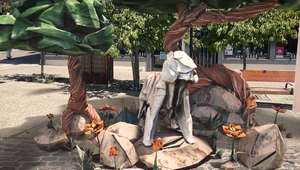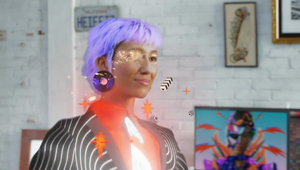
5 Minutes with… Tina Bejian-Binnion

Adobe XD is a proud supporter of LBB. As part of the sponsorship of the ‘5 Minutes with…’ channel, we spend time with some of the most innovative and creative minds in the industry.
Naturally curious and collaborative, Philadelphia native Tina Bejian-Binnion is an accomplished user experience (UX) strategist with 20 years of digital healthcare marketing and advertising under her belt. Now vice president and director of UX at Digitas Health, she utilises her expertise in user-centred design, scalable design systems, platforms, personalisation and more to shape how we interact with healthcare.
After two decades at the agency, leading experience strategy and design efforts for major pharmaceutical companies, she imparts some of her wisdom with LBB’s Ben Conway, speaking about her personal journey in the industry and how she navigates the challenges that UX strategists face today.
LBB> What creative content inspired or interested you most when you were growing up? do any tv shows, films and ads stand out to you?
Tina> I grew up watching a lot of TV and movies (especially anything ‘indie’) because at the age of 15, I worked as a clerk at my dad’s video store. What stood out to me has always been character-driven content that challenged norms with a strong artsy undercurrent (skewed toward the bizarre and comedic).
- Phil Hartman seasons of ‘SNL’
- ‘The Kids in the Hall’
- ‘Twin Peaks’
- John Hughes films like ‘The Breakfast Club’ (because I am a gen x-er, after all)
- Anything Tim Burton, although ‘Edward Scissorhands’ has to be my favourite
- Also, the works of Pedro Almodóvar, especially ‘Women on the Verge of a Nervous Breakdown’
As a teen, I was obsessed with ‘The Kids in the Hall’ – it was wonderfully irreverent sketch comedy coming out of Canada done by a troupe of four men who played so well together (it was especially great when they did drag) and would incorporate unusual camera movements and cinematic devices into their sketches; they would often throw some short films into the mix that were done in the style of arthouse cinema. I loved the dynamic between these players and the fact that among many other things, they were just a bunch of anarchist performers having a great time poking fun at other artists who take themselves too seriously.
LBB> What’s the most important lesson/piece of advice you received early on in your career? How does it influence you and your work today?
Tina> My first boss in advertising was Linda Holliday, one of the founders of Medical Broadcasting Company – the precursor to Digitas Health. She is a whip-smart, visionary leader who is always innovating.
Working under Linda early in my career was the best thing for me. There was no blueprint for the job because Linda’s role was vast and her needs were always evolving, as the trajectory of her company evolved. Whether or not I realised it at the time, my role as her assistant primed me with a few solid lessons every good UX designer/strategist should know:
1) We all share a common desire to understand each other and to be understood. People are people – no matter their role or title. Don’t make assumptions about them based on their intellect or status. Everyone has the capacity for misunderstanding just as everyone is in pursuit of clarity.
2) When you listen, observe and ask thoughtful questions (in that order) it always pays off. It shows that you are paying attention and gets you the help you need to achieve better understanding. In this industry, people expect you to instantly know everything about emerging tech. The reality is, there are so many layers of complexity and we don’t all have the same level of expertise. And you know what? It’s OK to admit that! Because when you do, people will step up and help you decode that complexity; because helping people makes you feel good, and it’s human nature to want to do things that feel good.
3) Make it artful. Aesthetics matter – especially in communications. Taking a few extra minutes to format something or add visuals to enhance what you are saying can bridge major gaps in understanding and people value it.
LBB> You celebrated 20 years at Digitas Health in November - how have you seen UX evolve in that time? What are some of the biggest evolutions that you had to adapt to?
Tina> Well, we all thought mobile responsive web was the big catalyst that disrupted the way we do web design, creating a major wave that forced a modular design movement called atomic design, which we still use today.
It turns out, spinning out from mobile-first responsive design, comes a bigger movement: the use of scalable design systems. These focus not only on the patterns we use to do the design but the tools, processes and roles needed to sustain that system. It is always being refined and optimised over time to meet the shifting needs of the business and the demands and current expectations of its customers.
But when compared to the game-changing potential of artificial intelligence (AI) and machine learning (ML), scalable design systems seem so basic. More and more design tools have AI features built in and the sophistication will only grow (exponentially faster) with time.
We have an ongoing healthy debate on this topic within our UX team here at DH; I believe the role of UX is evolving, taking practitioners further away from visual design and moving our roles closer to design thinking and collaborative design in new ways. Not only will we be using design-thinking methods to ideate and co-create with our clients and customers, but we will also see ourselves collaborating with the learning models, teaching them what good looks like by providing feedback based on insights we have around people’s needs, abilities and changing expectations.
This also means a greater emphasis on accessibility, health literacy, understanding contexts of use, mental models, modes of perception, learning and understanding - and less on usable interfaces because it’s likely AI will have that all sorted out.
LBB> You’re Philadelphia born and raised - how has the city influenced you and your career? What are some of the most underrated/unknown aspects of the city and its advertising scene?
Tina> True. I am a Delco [Delaware County] native, so in many ways, that’s probably more ‘Philly’ than Center City (just sayin’). I grew up watching Flyers Hockey in the '70s and '80s. Even though sports are not at all my thing now, I guess you can say it’s the grit that’s stuck with me and has influenced my career. And let’s be real, you can’t survive in the ad game without grit (especially when you’re in growth mode).
Incidentally, I would also say that the Philadelphia Flyers Mascot, Gritty, and how he turned the corner from being hated in Philly to becoming world-renowned was one of the best moments in Philly advertising. Check out Gritty on the socials – that comms team is just so on point!
LBB> What are some of the biggest challenges facing UX strategists right now? And equally, where are the most exciting opportunities in UX right now?
Tina> ‘Who owns the user experience’ shouldn’t be a matter of contention, but for many UX strategists, it still is. I think the challenges most of us in the field of UX face have to do with the role we play and the effect we have on the user experiences we deliver.
There are those in UX who are too focused on evangelising the value of following UX processes and lamenting about being marginalised or ignored by others on the team (designers who skip that process and jump right into design, or when user research gets cut from budgets, for example). But what I have come to know is that the best outcomes for teams and for projects happen in workplaces that foster a culture of collaboration.
Much of what I find exciting in UX relates to the power of design thinking and the emergence of remote collaboration features being built into the tools of our trade. If you are an aspiring UX practitioner, it’s worth honing and growing your design thinking and contextual inquiry skills.
UX practitioners and strategists succeed in creating positive outcomes for their clients and customers when they spend time building relationships with their teammates. We have the skills to build this culture of collaboration by ‘UX-ing ourselves’. Take time out to learn about the challenges your teammates and clients face. Empathise with them. Anticipate their needs and use your UX skills and methodologies, and volunteer to help them navigate to viable solutions.
LBB> What are some projects that made you particularly proud recently? Tell us a little bit about two or three of them!
Tina> Healthcare marketing often precludes us from touting/sharing our own work, but the sorts of projects I am often most proud of are the ‘double diamond’ ones. These tend to be projects that are high-profile for our clients, and they come with budgets to support an end-to-end user-centred design process.
One major UX coup happened back about four or five years ago; some very supportive clients asked us to rework their patient support program web enrolment process for one of their blockbuster products. This challenging project involved all the ingredients that make for UX success stories: supportive clients with big budgets, discovery of audience insights, hypothesis development and problem framing with collaborative partners, prototypes and rounds of co-creation and design validation, and last but not least, a modular solution that was built to scale over time. It was so gratifying to launch this and then see the uptick in engagement and enrolment metrics, and later to see it rolled out across a portfolio of products.
Another more recent point of pride is my involvement in launching the Digitas Health Accessibility Council with my fellow accessibility allies at DH. Our mission is to ensure that the practice of inclusive and accessible design is thriving, and always top of mind in the work we do. Compassion and a willingness to step outside yourself when you’re working are some of the keys to our success. It’s lovely to see awareness spreading to team members and it’s been wonderful watching clients and the design community at large embracing accessible design practices.
LBB> With tech and platforms evolving constantly at a rapid rate, how do you stay ahead of the developments in the UX field? What’s the best way to stay fresh and up-to-date?
Tina> Here at DH, we have one of the best UX teams in Philly. I learn so much from my colleagues. Shout out to our capability lead, Chris Murray, who keeps our weekly team meetings challenging and engaging. We use the time once a week to exchange ideas, debate, do design challenges and inspire each other. We have a Microsoft Teams group with channels where we can share articles and other content that keeps the topics fresh.
Outside of our DH UX brain trust, there are tons of curated feeds for just about any area of interest within UX. I usually check news emerging from key conferences throughout the year, like Adobe Max and events related to the products I use in my trade (anything Microsoft, Google, Figma, and Apple). I am a member of ‘Leaders of Awesomeness’, which is a newsletter from Jared Spool’s UIE Center Centre and that content is usually focused on support of the UX practice and how to handle challenges as a practitioner.
In terms of anything to do with emerging tech, content strategy, service design, prototyping and design tools and methodologies etc … I use Medium, Twitter (X?) and YouTube, and follow known leaders in various facets of UX – here’s a great list.
LBB> Outside of work, what do you do to decompress? Are you still roller skating around the office?! What are some of your favourite hobbies and relaxation tactics?
Tina> To the point of roller-skating around the office – I still keep a pair of skates by my desk (quads, ‘cause I’m old skool). And I do still roller skate with my 10-year-old daughter, who has recently picked it up. I also do karate with both my daughters, and we will be testing for our black belts in December.
I love working with my hands and love to crochet and do crafts. I’m gearing up to take on new hobbies all the time, but slow to get them going. My latest one (yet to be explored) is customising Blythe dolls. I saw these popping up on Instagram and even though I think dolls are generally quite creepy, there is something about these that seemed so expressive and artistic I just am itching to get one started.
LBB> What do you think it is that drives and motivates you in work and in your life?
Tina> I think the desire to do my best and be my best self was drilled into me from birth. I am a first-generation US native, born into an Armenian family that had experienced strife and hardship, as many still do today. My parents moved to America from Syria, and they came from humble beginnings with no formal education. There were seven of us living in a row house (including me, my two sisters, parents, and elderly grandparents).
My family expected me to be loyal, obedient and work hard, and give back to my community. And since I love my family, I’ve done my best to live up to those expectations (in my own way). This has made me into the sort of person who had to rise above her circumstances to make a better life and future for herself. It sounds like a cliché, but that’s my truth. There is no greater motivator than love. I take care of myself and my family and give back as often as I can out of love for this beautiful life I am so fortunate to have.















